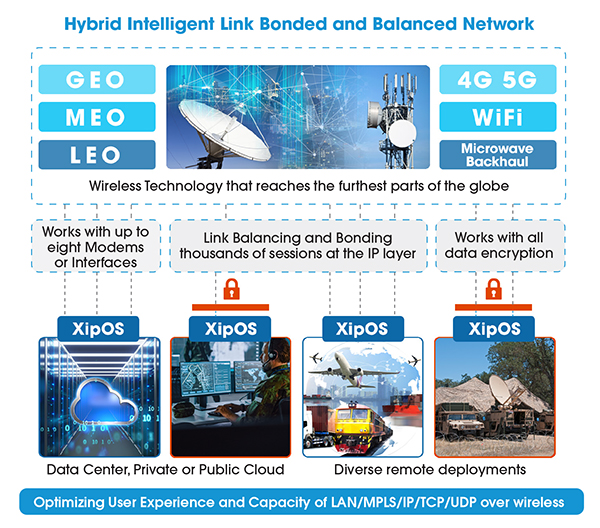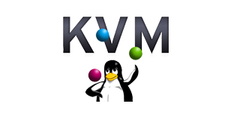Enhance user experience and network efficiency while securely scaling hybrid networks
XipLink technology delivers the most advanced satellite and wireless optimization, assuring the best possible ‘goodput’ at a reasonable cost. The technology has been perfected over decades of intense and dedicated focus in the Wireless Link Optimization environment and includes multiple mechanisms that operate at several layers of the networking stack.
The XipLink Optimization Software (XipOS) can be provided as a software virtual network function (XV prefix) that scales from 1,000 to 300,000 TCP sessions on a desktop or 1U platform. Aggregate throughput beyond 2Gbit/s is delivered via a highly-scalable virtualized blade server. XipOS software is deployed as a virtual function and is remotely managed using a user-friendly Graphical User Interface or can be centrally managed via XipLink central management software (XMS).
Conveniently integrated hardware appliances are available for projects where no Edge CPE is available. These appliances are identified by the XA prefix. XipLink also provides high speed, fully integrated appliances for deployment to satellite ground stations or hybrid cloud environments.
All major VM hypervisor systems are supported KVM/QEMU and VMWare ESXi or Player.

XipLink devices work over any wireless, wireline or hybrid network including the following network technologies;
- VSAT and Access Networks (TDMA / SCPC / Mesh)
- Terrestrial Wireless (WiMax / Microwave / Extended WiFi)
- Cellular / LTE (2.5G / 3G / 4G / 5G Interconnect and Backhaul)
- Terrestrial (Point-to-Point and Point-to-Multipoint)
- MSS (Inmarsat®, Iridium® and equivalent)
XipLink Optimization System (XipOS)
SCPS-TP Protocol Acceleration -Fills the wireless link to capacity- SCPS-TP based TCP acceleration
- Fixed, Dynamic, & Delay-Based Rate Control
- Ack Frequency Reduction with SNACK
- Faster page start and finish for HTTP & HTTPS
- Video plays earlier, delivers consistent quality
- Sustain 1080p and 4K UHD video streaming
- Intelligent traffic shaping
- Hierarchical QoS classes
- Automatic estimation of link speed & quality
- Dramatic bandwidth gain, as high 10% - 30%+
- Packets Per Second (PPS) benefits for VoIP, VoLTE, Voice Apps using XipLink Real Time (XRT)
- Increase capacity and/or reliability
- Single stream scaled over multiple paths
- Steer selected traffic to specific links
- Supports 2.5G, 3G, 4G/LTE, 5G & Wi-Fi hotspots
- 30%+ traffic reduction and 100 Mbps+ TCP
- Transparent VLAN support
- GRE and GTP tunnel traffic optimization
- VXLAN and MPLS support
- Decrypt/optimize/encrypt (DOE) approach
- Compliant with 3GPP standards for MNO’s
- Effective on non-encrypted repeated content
- Up to 80% reduction on applicable traffic types
- IP-layer: Effective for both TCP and UDP traffic
XipOS Software Features
User Experience
TCP Acceleration using the SCPS-TP standard, scalable TCP up to 1Gbit/s per XV image, fast start, congestion controls, acknowledgment frequency reduction, selective negative acknowledgement, DNS caching
Optimization Features
Packet Coalescing with Header Compression, Stream Compression, Byte Caching
Transparent Tunnel Acceleration
Accelerate TCP embedded in tunnel technologies: Transparent GTP (4G and 5G), GRE, VLAN, MPLS and XipLink Lightweight Tunnels (XLT)
Layer 2 Support
Layer 2 over Layer 3 (VXLAN) and VLAN Tagging
Traffic Steering with Link Balancing & Bonding
OverSite traffic steering policies steer and overflow unique groups of traffic onto one or more links, based on link status, protocol, IP source and destination address and subnets, port numbers, DSCP mark, VLAN ID, VLAN priority and MPLS label. Links are actively monitored for congestion and buffer bloat. Sessions are smoothly moved to alternate links, within seconds of a link degradation or failure. Bandwidth Bonding uses the available bandwidth of all links, for any IP traffic, including UDP and TCP/IP.
Advanced QoS
Class based weighted fair queuing (CBWFQ), Min/Max/Guaranteed Bandwidth setting, Bandwidth Pooling, Allow/Deny, Selective Optimization
Security
VPN / IPsec, Pre-Shared Secrets, X509 Certificates, CMPv2, IPsec Decrypt-Optimize-Encrypt (DOE) supports acceleration of encrypted traffic
Traffic Types Supported
IPv4, IPv6, GRE, MPLS, VLAN, GTP
Network Mode
Bridge Mode, Router Mode
IP Routing
Static Routes, BGP, RIP, OSPF
Redundancy/Resiliency
LAN By-Pass, Rapid STP, CARP/VRRP, Multiple OS partitions



